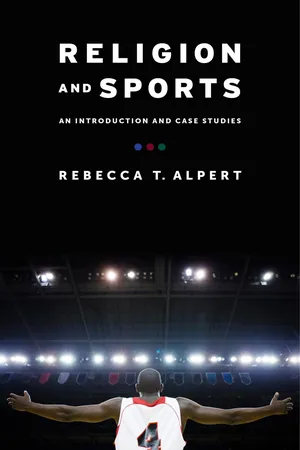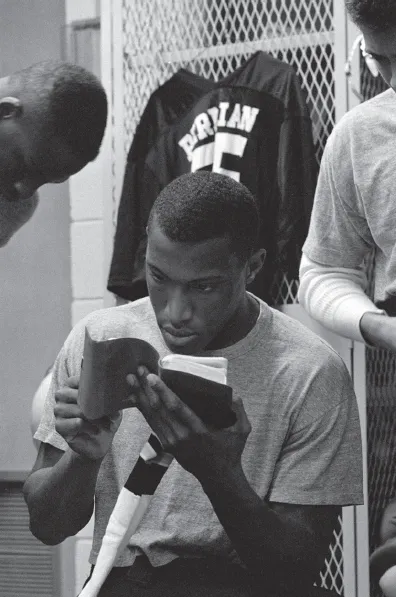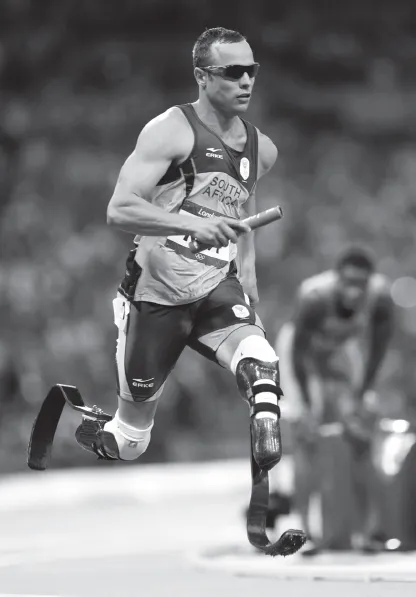![]()
PART 1
WHY DO PEOPLE THINK SPORTS ARE A RELIGION?
In this section we will be examining two cases that help us understand why people have claimed that sports are their religions. What makes sports sacred to some people? Are sports symbols and rituals worthy of being identified as religious? Are they appropriate sites for people to invest with holiness? Do sports represent our highest values? Should sports heroes be idolized? Should they be held to a higher standard than other human beings? The high school football culture in Odessa, Texas is an example of what happens when sports becomes the “religion” of a municipality. In case 1, Buzz Bissinger’s ethnographic account of life in Odessa, Friday Night Lights, we will highlight how sports can become a religion through the story of a small-town community that lives through their high school football team. Case 2, the story of double amputee runner Oscar Pistorius, will help us see how sports has raised questions understood to be religious about what it means to be human, how we understand justice and fairness, and what are the qualities a person needs to be a moral exemplar.
![]()
CASE 1
Friday Night Lights
HIGH SCHOOL FOOTBALL AS RELIGION IN ODESSA, TEXAS
Fig. 1.1. Player reading a Bible in the locker room from Friday Night Lights. Robert Clark/INSTITUTE.
GOAL: Form a well-reasoned opinion about whether high school football should be understood as, is similar to, functions as, or is not at all a religion for the residents of Odessa, Texas.
READ: Friday Night Lights: A Town, a Team, and a Dream by H. G. Bissinger (Boston: Addison-Wesley, 1990).
H. G. “Buzz” Bissinger took a one-year leave of absence from his job as a reporter for a local newspaper, the Philadelphia Inquirer, to observe the experiences of a storied high school football team in Odessa, Texas, the Permian Panthers. Beginning in 1946, the Panthers were perennial contenders and had won several Texas state championships. Through the 1990s their Friday night games were the heart and soul of the town. From the beginning of the season until its end, the players, coaching staff, boosters, and cheerleaders (the Pepettes) spent all their time and energy preparing for, attending, and celebrating or mourning the results of the games. Odessa’s weekly activities were centered on the team, and the town’s attention focused on each game and each team member.
Bissinger was curious about the culture of high school football and wanted to understand how high school football defined life in Odessa. Friday Night Lights is a critically acclaimed journalistic account of Bissinger’s experience chronicling the 1988 season in the context of the economic, racial, and social changes the town was experiencing. The book, which used the real names of the players and coaches, was made into a (fictionalized) major motion picture in 2004, and yet another version was adapted for television by the film’s director, Peter Berg. The network series aired for five seasons (2006–2011). Although they did not garner a lot of popular attention, both the film and series were well received by critics. Bissinger’s book continues to be widely read and used as a course text in college classrooms like this one.
Friday Night Lights highlighted racial, social, and economic issues in the oil-based boom or bust economy of this small town in West Texas, which had been cited by several magazine surveys in the 1980s as one of the worst places in America to live. But high school football was at the core of what made life livable, and the city made huge financial investments in the Panther team’s stadium, equipment, and travel.
Bissinger was not himself interested in the question of whether high school football could be called a religion, and so this book provides a neutral platform for us to ask that question. For this case study, you must read Friday Night Lights. It is important to look at the activities associated with this case study BEFORE you read so that you can be on the lookout for the keywords, stories, descriptions, and quotations you will need to answer the questions. Although you will have no trouble accessing plot summaries and reviews on the Internet, and you might thoroughly enjoy the film and TV series, you will only be able to answer the questions posed here by reading the book.
ACTIVITIES
ACTIVITY 1
Part 1 at home
STEP 1
Review the section of the introduction to this text that provides a variety of definitions of religion and the section that lays out the arguments for and against understanding religion and sport.
STEP 2
Find five examples (quotations, stories, or descriptions) in FNL that illustrate a possible connection between religion and sports.
Sample
The faces of the players were young, but the perfection of their equipment, the gleaming shoes and helmets and the immaculate pants and jerseys, the solemn ritual that was attached to almost everything, made them seem like boys going off to fight a war for the benefit of someone else, unwitting sacrifices to a strange and powerful god. (11)
STEP 3
For each quotation, story, or description, write a one-paragraph explanation (based on the introduction) of why you chose that quotation, story, or description. How does it illustrate a possible connection between religion and sport? Make sure you indicate which definition of religion you are referencing.
Sample
This quotation illustrates the potential of sport to function as religion. It includes several of the elements Ninian Smart defined as aspects of religion: belief (“a strange and powerful god”), rituals (sacrifice and other elements defined here as “solemn”), material objects (“gleaming shoes and helmets and immaculate pants and jerseys”), and belonging (“for the benefit of someone else”). The reference to going off to fight a war could connect to Robert Bellah’s concept of civil religion and its analogies to patriotism.
STEP 4
Using the arguments against viewing sport as religion, explain why some might argue against the segment you chose.
Sample
Higgs argues that sports represent everything that was wrong with ancient religions: violence, sacrifice, and the connection to war. All those factors are present in this quotation. Guttmann suggests these links to ancient religions that might be represented by sport in ancient times no longer matter in the highly corporatized world of sport today. This example is more about the connection between football and war rather than football and religion.
STEP 5
After having done this exercise for each quotation, story, or description you’ve chosen, you decide. Having viewed the argument from different perspectives, are there sufficient examples in FNL that point to Mojo as a religion in this case study? Use specific examples in making your final argument.
Part 2 in class
STEP 1
Meet in pairs and compare your quotations, stories, and descriptions. If you used examples that you didn’t have in common, describe them to each other. Look at the ones you found in common and compare your conclusions about them. Discuss the differences. Decide which of your examples make the best argument in favor of the connection between sport and religion and which make the best argument against the connection.
STEP 2
Each pair presents their best arguments.
ACTIVITY 2
STEP 1
Buzz Bissinger had no interest in the question of whether he was describing a religion or not. Yet it is clear that he uses language often associated with religion (sacrifice, ritual, God, saints, faith) to describe the Panthers and their loyal fans. Find five times Bissinger uses the term religion. For each instance, write a paragraph about what you think he means when he’s using the term. Use the definitions you find in the introduction to do this part of the exercise.
STEP 2
Create 3 questions to ask Bissinger for a mock interview focused on the connection between sports and religion. Submit the questions you’d like to ask him about his views on this topic to the discussion board of your course’s electronic Web site.
STEP 3
Pick out one question submitted by another student and answer it as if you were Bissinger. You may choose to do further research about him to find out more about his interests and attitudes about religion to inform your answer.
Extra Credit
Watch the film Friday Night Lights. List the scenes that you think have a religious dimension and explain why.
![]()
CASE 2
Oscar Pistorius and What It Means to Be Human
Fig. 2.1. Oscar Pistorius runs during the men’s 4 × 400 meter in the Olympic Stadium at the 2012 Summer Olympics, London. AP Photo/Lee Jin-man.
GOAL: To apply our understanding of sport as a religion to the values connected to human embodiment, justice, and fairness.
Oscar Pistorius achieved international fame in 2012 when he became the first double amputee runner to compete in the Olympics. He had already won multiple races in the Paralympics against mostly single amputee athletes and sought to test his abilities at this next level. Whether or not Pistorius would be allowed to compete against able-bodied athletes on his “cheetah legs” was initially adjudicated by the International Association of Athletics Federations (IAAF), which passed a rule in 2007 against allowing runners to use devices with springs or wheels in anticipation, it was widely believed, of Pistorius’s contemplated goal. The ruling was later overturned on appeal by the Court of Arbitration of Sport, paving the way for Pistorius to compete in London.
Then, at the height of his fame, on Valentine’s Day 2013, Pistorius killed his girlfriend, Reeva Steenkamp, claiming that he mistook her for an intruder. The trial lasted for a year and was closely watched as people around the world (and especially in South Africa) questioned whether Pistorius could still be a hero. Although judge Thokozile Masipa ruled that the act was not premeditated, she did find him guilty of culpable homicide and another firearms-related offense.
Whether or not sports is a religion, as a society we often ask religious questions in the context of sports. Pistorius’s case lends itself to thinking through ultimate questions as expressed in two of the dimensions of religion outlined by Ninian Smart (see the introduction): the ethical/legal and the doctrinal/philosophical. What does it mean to be human? Is there such a thing as normal? Natural? Is it right to sort human beings into different categories based on age, gender, or physical ability for sports competitions? How do we decide what is just? What is fair? What makes someone a hero? Is hero a category for a man who is convicted of the reckless use of firearms that resulted in someone’s death?
Oscar Pistorius was born in 1986 and raised in Johannesburg, South Africa. Born without a fibula in either leg, he would never be able to walk. His parents decided to have doctors amputate his legs below the knee when he was eleven months old in order to permit him to walk using prosthetic devices. His parents divorced when he was young, and his mother died when he was fifteen. As a child he played sports including tennis, water polo, and rugby. In his autobiography he describes how a rugby injury led to the start of a career as a sprinter in 2004. Pistorius claimed not to have any interest in running; his original goal was to rehabilitate so he could return to playing rugby. But when he was fitted with running blades that allowed him to run swiftly (as compared to the ones he used as a child), he discovered both his great ability, and the joy of movement. His talent was such that he soon outgrew the blades he was using and so was fitted with a newly designed J-shaped prosthetic manufactured by an Icelandic manufacturer, Össur, called the “flex-foot Cheetah.” Using this device, Pistorius quickly claimed a new nickname, Blade Runner and status as “the fastest man on no legs.” Although he doesn’t describe himself as religious, he identifies as a Christian and was close to his mother, who herself was most devout. One of his two tattoos is the verse from 1 Corinthians 9:26–27, “I do not run like a man running aimlessly.” His career as a runner took on passion and purpose.
Although Pistorius was classified as T43 (double amputee), he competed and won events in the T44 (single amputee) category in Paralympic contests beginning in 2004. He won the bronze medal in the 100 meter event and the gold medal (and a world record) in the 200 meter in Athens in 2004, and gold in the 100, 200, and 400 meter events in Beijing in 2008. He continued to compete in the 2012 Paralympics, winning silver in the 200 meter, and gold in the 400 meter and 400 meter relay, all against single amputees.
In 2005 he began running in able-bodied national and international competitions as well. Pistorius contemplated competing in the 2008 Beijing Olympics, but in 2007 the IAAF banned “any technical device that incorporates springs, wheels or any other element that provides a user with an advantage over another athlete not using such a device.”
The concern, as it was expressed, was about a “slippery slope.” If the prosthetic devices were allowed, as one official put it, someday someone would want to “fly with something on their back.” It was even suggested that people might amputate their legs to gain an advantage. Although the IAAF did not say so, it is widely believed that this ruling was meant to keep Pistorius out of the Olympics, as word had gotten around that the “cheetah legs” he was running on might present an unfair advantage. The IAAF denied that the rule was created for Pistorius, then requested that Pistorius undergo scientific testing to determine whether the prosthetics did create an unfair advantage. Pistorius agreed to take par...




